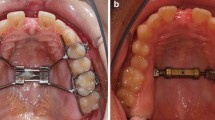Abstract
Introduction:
It was the aim of this study to carry out a 3-D analysis of the teeth, alveolar and skeletal structures during bone-borne, surgically-assisted rapid maxillary expansion (RME) with the Dresden Distractor (DD). We aimed to determine whether a translatory and skeletal movement of the segments would be possible while reducing the dento-alveolar side effects associated with tooth-borne RME.
Materials and Methods:
Standardized axial computed tomography (CT) was performed on twelve patients averaging 25.3 years of age prior to and after RME with the DD. Reference planes and the triple-0-ELSA were defined bilaterally referring to the following anatomic points: the foramina spinosa, external auditory meati and the anterior margin of the foramen magnum. We measured the amount of movement that occurred before and after RME with the DD against ELSA.
Results:
A screw activation of 6.0 mm led to a transverse expansion of 5.55 mm in the alveolar process in the premolar region, and of 4.87 mm in the molar region, with 8° to 9.8° of buccal tip** and an increase in width of 6.07 mm and 5.71 mm, respectively, occurred in conjunction with only slight buccal tip** of the premolars (3.1°–4.6°) and molars (1,1°–2.6°). These data signify, beyond the considerable skeletal efficacy, an uprighting of the teeth due to the multibracket appliance's torque effect, and a direct transfer of the expansion forces onto the bone. Autorotation of the mandible in forward and upward directions was possible due to the considerably less dental tip** resulting from RME with the DD in comparison to tooth-borne RME. This fact demonstrated that the DD is also well-suited for patients with vertical growth pattern.
Conclusion:
The bone-borne DD is an effective therapeutic method that spares the patient the negative side effects associated with tooth-borne RME such as root resorption, bone dehis- cence, bite opening and excessive buccal tip** of the teeth. The prerequisites for stable occlusion are brought about by the fact that the expansion is skeletal in nature, with minimal dental tip**.
Zusammenfassung
Ziel:
Ziel der Studie war die 3-D-Analyse von Zähnen, alveolären und skelettalen Strukturen bei der knochenverankerten, chirurgisch unterstützten Gaumennahterweiterung (GNE) mit dem Dresden Distraktor (DD). Es sollte überprüft werden, ob eine körperliche und skelettale Bewegung der Segmente mit einer Reduktion der bei der zahngetragenen Gaumennahterweiterung auftretenden dentoalveolären Nebenwirkungen erreicht werden kann.
Material und Methodik:
Bei zwölf Patienten, Durchschnittsalter 25,3 Jahre, wurden vor und 6,8 Monate nach der GNE mit dem DD standardisierte axiale Computertomogramme (CTs) erstellt. Mittels der anatomischen Referenzpunkte Foramina spinosa und Pori acustici externi beidseits sowie dem Vorderrand des Foramen magnum wurden Referenzebenen und der Tripel-Nullpunkt ELSA definiert. Bewegungen der Messpunkte vor und nach GNE wurden gegen ELSA vermessen.
Ergebnisse:
Die Schraubenerweiterung von 6,00 mm führte am Alveolarfortsatz in der Prämolarenregion zu 5,55 mm und in der Molarenregion zu 4,87 mm transversaler Erweiterung mit 8°–9,8° Bukkalkippung. Die geringere Bukkalkippung der Prämolaren von 3,1°–4,6° und der Molaren von 1,1°–2,6° bei einer Breitenzunahme von 6,07 mm bzw. 5,71 mm verdeutlichte neben der großen skelettalen Effektivität eine Aufrichtung der Zähne durch den Torqueeffekt der Multibracketapparatur und die direkte Einleitung der Expansionskräfte auf den Knochen. Die im Gegensatz zur zahngetragenen GNE geringe Zahnkippung der GNE mit dem DD erlaubte eine Autorotation der Mandibula nach ventral und kranial, so dass der DD auch bei vertikalem Wachstum gut geeignet war.
Schlussfolgerung:
Der knochenverankerte DD ist eine effektive Therapiemethode, welche vor unerwünschten Nebenwirkungen zahngetragener GNE wie Wurzelresorptionen, Knochendehiszenzen, Bissöffnung und exzessiver Bukkalkippung der Zähne schützt. Die vorwiegend skelettale Expansion bei geringer Zahnkippung schafft die Voraussetzung für eine stabile Okklusion.
Similar content being viewed by others
Author information
Authors and Affiliations
Corresponding author
Rights and permissions
About this article
Cite this article
Hansen, L., Tausche, E., Hietschold, V. et al. Skeletally-anchored Rapid Maxillary Expansion using the Dresden Distractor. J Orofac Orthop 68, 148–158 (2007). https://doi.org/10.1007/s00056-007-0643-z
Received:
Accepted:
Issue Date:
DOI: https://doi.org/10.1007/s00056-007-0643-z




